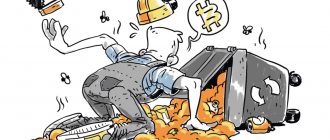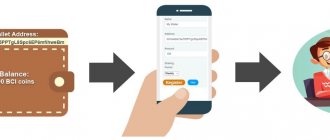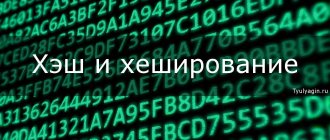When I decided to figure out what bitcoins are, I spent a long time searching for information all over the Internet. But all the “simple words” explanations only created even more confusion in my head. And then I did my own research.
And if you now, like me once, do not understand the essence of Bitcoin - is it a scam or not, and is it possible to make money on it, and how does it all work - then spend five minutes on this article. I promise you won't have any more questions.
And let's first deal with the materiel. Where do Bitcoins come from and what is it? Who “prints” them? And if no one, then why is all this devilry called currency?
Bitcoin is the first and main cryptocurrency
There are thousands of cryptocurrencies. The first cryptocurrency that appeared in the world was Bitcoin, in English Bitcoin, short for BTC. In this article, for simplicity, we will talk mainly about Bitcoin.
All other cryptocurrencies are clones of Bitcoin. They were completely or partially copied, and new ideas were added somewhere. This became possible because the Bitcoin program code is open to everyone - this is not a secret. Anyone in the world can see how it works and works.
Finding Lost Bitcoins
The Bitcoin code is located on GitHub in the bitcoin repository.
Don't you understand anything about programming? Don’t worry, the authors of this article don’t understand either, but this doesn’t stop you and me from using cryptocurrencies.
By the way, here we will make the first reservation. You and I have to take on faith what the programmers who invented Bitcoin did. Should we be afraid of this? Not worth it. You don’t know thoroughly how your car works from one screw to the next, or how the computer works in it, right? It’s the same here. Programmers all over the world are eager to find at least some kind of flaw in the operation of the Bitcoin network, so, believe me, if there was an error, it would have been found long ago. We simply trust the professionals who assembled our machine and tested it, the same with Bitcoin: millions of programmers in the world read and study Bitcoin code every day.
Bitcoin code
Bitcoin has its own source code. It is open, so programs are available for study and editing. On the one hand, this feature guarantees the transparency of the blockchain. Thanks to this, you can ensure its reliability. On the other hand, it makes it possible to use such a key for your own purposes.
The Bitcoin source code does not belong to anyone, not even the developers, although they have indirect influence on it. This key can be managed and used by absolutely all participants and miners.
Bitcoin is considered public domain. The creators of this cryptocurrency did not want to advertise their real names, preferring to use the pseudonym Satoshi Nakamoto. They do not claim the rights of owners, completely leaving the management of the payment system to ordinary users.
What is cryptocurrency, who controls it? Can you touch Bitcoin?
Bitcoin - electronic money
Judging by the name “cryptocurrency”, you understand perfectly well that we are talking about money. Only this money is “crypto”, that is, it is encrypted in some way. What and how is encrypted is of no interest to you and me at the moment. Let's assume that cryptocurrency is electronic money.
What does electronic mean? Look, regular currency can be printed (banknotes) or electronic (bank account). When you transfer money from your account to a friend's account, pay utility bills through online banking, when you pay with a bank card in a store - in all these cases you do not see the money. They are somewhere virtually on some computer servers. You don't see them and you can't touch them with your hands.
Bitcoin has been around for over twelve years
You can go and withdraw 5 thousand rubles from an ATM from your bank card and put it under your pillow. In this case, your electronic virtual money will become real. You can touch them, admire them, hang them on the wall. In the case of Bitcoin, this cannot be done. You cannot go to a cashier, cash out Bitcoin and put some BTC coin under your pillow. Of course, you can exchange Bitcoin for rubles and put rubles under your pillow, but these will already be rubles.
Is this scary? In our opinion, it’s not scary at all. Even grandmothers (the majority) have been receiving pensions in bank accounts for a long time, have been using savings books for decades and do not use real money.
How many Bitcoins and rubles are there?
According to the Central Bank of Russia, more than 25 trillion rubles in cash were printed. In addition, virtual electronic rubles are stored in bank accounts. How many are there? No one knows. The story is similar with the dollar, euro, pound sterling or any other common currency. We do not know and cannot control how much of it exists, and how much will exist tomorrow or in a year. The process of emission (release) of the ruble is not controlled and cannot be predicted by us. And at any moment the government of any country can print more pieces of paper.
With Bitcoin everything is much simpler. There are now just under 19 million Bitcoins (BTC) in the world. Approximately 900 new BTC appear every day, but over time the number of Bitcoins appearing daily drops. There will be a total of 21 million Bitcoins in the world, 20,999,999.9769 BTC to be more precise. All. No more, no less.
Large companies are buying Bitcoin
If the Bank of Russia decides to print 100 million rubles, it takes and prints them. He won't question you or us. This will not work with Bitcoin. There will only be 21 million coins. You won’t be able to “print” a couple more BTC later - it’s impossible.
Who controls the currencies?
Conventional currencies are managed by countries' central banks. The ruble is controlled by the Central Bank of Russia, the dollar by the US Federal Reserve System, and the euro by the European Central Bank.
Russia and digital currencies
No one controls Bitcoin. Bitcoin is an anarchic system. It has no boss; everything that happens in the system of this currency is described by program code. In the next chapter we will look in detail at how this is possible.
Well
Cryptocurrency rates indicate indicators on the cost, capitalization and degree of anonymity of actively developing virtual currencies. Since its creation, Bitcoin has confidently demonstrated high performance in all these parameters.
Bitcoin rate 05/21/2020:
| Cryptocurrency | Price | Change (24 hours) | Trading volume (24 hours) | Market capitalization |
| Bitcoin BTC | $9374.49 | -4.02% | $34,441,619,422 | $172,324,376,787 |
Bitcoin rate
Using Bitcoin and other cryptocurrencies
Unlike regular money, cryptocurrencies are impersonal but completely transparent. Such is the paradox. This means that you can look at any Bitcoin transfers throughout the history of its existence. There will be no names in the “Sender” or “Recipient” column, but there will be wallet addresses - these crazy ones that we have already seen, for example, 1CKXsyrhF9zfzizZb1x9zwkHczjxNRc6by.
On the one hand, this provides complete anonymity. On the other hand, if you combine a living person and his Bitcoin address, you can see absolutely all of his transfers. To what addresses and how much did he transfer? It must be said that any person can have an infinite number of Bitcoin addresses, but it is not always possible to remain completely anonymous.
An important point that distinguishes Bitcoin from the Ruble, Dollar or Euro is that Bitcoin is not regulated or protected by anyone. A simple example.
If you transferred 1000 rubles not to your grandmother, but to another person’s account. What are you going to do? Contact the bank, write an application, they will most likely help you and return your funds.
Bank and Bitcoin
If you transferred 0.1 BTC not to your grandmother, but to someone else’s address, in a high degree of probability you will never get it back. There is no mechanism to return the money. There is no way you can contact the recipient so that he “gives in a good way.” There are no Bitcoin police. You have no leverage at all.
In this regard, cryptocurrencies are more like cash. If cash is stolen, it will be impossible to find it. Storing cryptocurrencies can be just as dangerous as holding cash. Except that cash is the size of pieces of paper, you can’t hide a lot of them, but bitcoins in any quantity can fit on a flash drive, and what can we say, in one small file on the computer.
An important difference between cryptocurrency transfers and transfers of conventional currencies. If you transferred Bitcoin and this transfer is already sealed in the blockchain, then the money has left you and reached the recipient. There is no other option. Anyone in the world can verify this. If you transferred rubles from account to account, they could leave one place, arrive at another in a day, two, or they could even get lost along the way due to the poor performance of banks.
Where and how can you use cryptocurrencies?
Typically, cryptocurrencies are used for the following purposes.
ASIC miner
Mining should never be confused with investing. Of course, the same person can be both a miner and an investor, but there is still a difference. Mining is income here and now. Investing is “for the future.”
Principle of operation
Bitcoins are records in a blockchain (a replicated distributed database) that stores all information about transactions. The addresses of coin owners are also stored there. Data about senders and recipients are private. They are inaccessible to unauthorized persons. Blockchain does not provide information about the amount of virtual money owned by a particular person. The current amount of cryptocurrencies can only be calculated from a chain of transactions carried out from a specific address. Such calculations are carried out by the client program. But, if necessary, it is possible to calculate the number of bitcoins yourself.
Bitcoin storage
Regardless of how exactly you want to use Bitcoin, you need to create a wallet. Choosing a wallet is an important aspect. The security of your cryptocurrency is in your hands. We remind you once again that if your cryptocurrency is stolen or you lose it yourself, no one will restore it! Whatever wallet you choose, there is a risk of losing your Bitcoin. Depending on the wallet and storage method, the risk is higher or lower.
Details:
If you do not intend to store large amounts and are just starting your cryptocurrency journey, we recommend one of the multi-currency crypto wallets. They are available on computer and mobile phone. For example Coinomi or Trust. Be sure to save passwords and special recovery phrases in safe places, as wallet creators recommend.
So-called hardware wallets will be one step safer. Special flash drives that you insert into your computer are somewhat similar to 1C keys in an accountant’s computer. The main danger in the case of such wallets is buying secondhand or from unverified sources. The hardware wallet must be new and purchased directly from the manufacturer.
The same Bitcoin
If you decide to store large amounts, you need to consider more reliable storage. For example, you will need to buy a separate computer to store cryptocurrency and several flash drives.
Remember that scammers and hackers are around every step of the way. When using cryptocurrencies, you must build your own defense against them. There will be no help.
Conclusion
Cryptocurrencies have caused inevitable fluctuations in the financial market. The development of Bitcoin entailed enormous support from users, and accordingly, this cryptocurrency began to grow in price. Bitcoin cannot be called the currency of the future, and there are a number of reasons for this, which were described above. Sooner or later, this financial bubble will have to burst. There are quite a few reasons for this and it would take a long time to list them all.
But if you think about cryptocurrencies in general, you can count on the continued development of such projects. Now, in the age of IT, these are necessary measures. After all, the cryptocurrency market is part of an area that has now reached critical popularity and growth.
The current global financial system needs to be completely replaced or at least modernized. Therefore, the development of these technologies must be supported, which will be done. And the technologies that were used to develop Bitcoin will become the basis for the development of new currencies.
Payment, purchase, sale, exchange of Bitcoin and other cryptocurrencies
For the operations of buying and selling Bitcoin, as well as exchanging it for other cryptocurrencies, there are special cryptocurrency exchanges and exchange services. Most of them require registration and provision of personal information - for example, a passport. You can also find exchanges that still operate anonymously.
In any case, exchanging one cryptocurrency for another is usually much easier than exchanging cryptocurrencies for rubles. All you need to do is go to one of the exchanges where various exchange options are available to you. The most famous exchanges in the world: Coinbase, Gemini, Kraken, Binance. Not everyone works with clients from the CIS countries.
Buying cryptocurrency
You can also use the Telegram bot to buy or sell Bitcoin. This is a working option, especially for buying and selling small amounts.
Is cryptocurrency legal in Russia?
The Law on Digital Financial Assets and Digital Currency was adopted on January 1, 2022. According to this law, cryptocurrency can be an investment object, but cannot be used to pay for goods and services.
As you can see, from the point of view of the law, you cannot pay for anything with Bitcoin in Russia. In other countries, legislation is different. In some places, cryptocurrency is allowed, in others it is prohibited, in others its status is still not regulated in any way.
Prospects
Most experts unanimously speak of an increase in the value of Bitcoin in 2022 – up to $30,000, up to $50,000 and even up to $100,000. It is noted that the currency is now experiencing truly sustainable growth, which is no longer similar to the hype of 2017. Many institutional investors, large companies, and payment systems have paid attention to Bitcoin. All this speaks in favor of the further growth and development of cryptocurrency.
There has been a significant strengthening of Bitcoin's foundation, making it look like an effective defensive asset in the eyes of both large and private investors, which saves savings from inflation, just like gold. Following the growth in popularity of the first cryptocurrency, the rest are also following, so we should also expect an increase in the price of altcoins.
Mining
Mining is not as complicated as you might think at first glance. The scary word “cryptocurrency farm”, which is used to scare people on television news (usually when someone doesn’t pay their electricity bill), is not so scary.
Mining equipment
There are two types of mining equipment:
- Special devices for mining, the so-called ASIC (Special Purpose Integrated Circuit). It is a small metal box, inside of which there are microcircuits, and on the sides there are fans for cooling.
- Computer video cards. The same video cards that are used for computer games. To increase performance, special computers are usually assembled, with an open case for better cooling, and not one, but several video cards are installed in one computer.
Bitcoin mining is carried out only using ASIC devices, while Ethereum is mined on video cards.
Video cards vs ASIC
There is also luck in mining. Read more about this important indicator in a separate article.
Both ASICs and video cards consume a lot of electricity, and they get very hot during operation. Remember this.
Is it difficult to start mining?
In the modern world, the difficulty of mining is very high, and the process occurs only through the so-called mining pools. Mining pools are servers that unite miners. Miners work together and receive rewards. The mining pool distributes this reward in a fair manner and pays out the earned cryptocurrency to each miner.
If you have a desktop gaming computer with a video card installed, you can start mining today - it's not difficult. Go to 2CryptoCalc and see which cryptocurrency is profitable to mine on your video card. Next, follow the instructions of the mining pool. You will need to download a special miner program and install the wallet of the cryptocurrency that you are going to mine.
Antminer Bitmain S19 Pro
If you want to mine Bitcoin, a regular video card will not help you. The only option is to purchase a special ASIC device. One of the most advanced Antminer Bitmain S19 Pro at the moment. Consumes 3.5 kW from the network and makes noise like an airplane. You can't put one like this at home.
However, setting it up is not at all complicated, all you need is to enter the address of the mining pool and the address of your Bitcoin wallet in the ASIC settings, connect the device to the Internet and plug it into a power outlet.
How to get the source code
The source code can be found in the public domain on GitHub. This service is used by developers. There are keys for joint study, discussion and creation of new programs. Among other things, open source code demonstrates the reliability of the blockchain. In addition to Bitcoin, on this portal you can find code data from companies such as Google and Microsoft.
How to get the source code
How to Manage Code
Each user who has special software installed on their PC can manage and change the code. The blockchain is managed by all participants equally. At the same time, they follow generally accepted rules. These rules are set by coin owners who make large transactions. Those who have powerful computers have the same opportunities.
Editing software is not difficult, but it requires the approval of other participants. Therefore, there are special resources where public keys are located. There, programmers discuss changes and agree on them. This is important, since any code transformation can lead to the creation of a completely different network - a new cryptocurrency. Coordination is necessary, since after a key change a new version of the program appears and all participants must update it.
Developers cannot influence the use of any software. The decision is made by the coin owners themselves. The creators can only advise updating it. If a bug is found in the updated software, they have the right to recommend rolling it back to the previous version. In this case, the advice must be reasoned. New software versions released by developers may be ignored by users. They have the right to make their own choices.
Managing keys is quite easy. It is much more difficult to convince coin owners that the changes were justified. They need to prove that it is preferable to use the fork as a full-fledged Bitcoin. To avoid network splits and disagreements, programmers introduce soft forks. With such changes, it is impossible to switch to another network in separate groups. Either everyone passes or no one passes. To make a consolidated decision on currency changes, participants vote using hashed power. Those who voted against will not be able to perform valid (authoritative) transactions. Such transactions will be considered invalid as they do not comply with the rules of the new network. Developers cannot influence the decisions of users and personally adjust programs. However, they may create conditions in which participants are forced to accept new rules.
Any group of miners can correct the code content. But if the fork contradicts the interests of other users, then the latter can change the cryptocurrency protocol with the mining algorithm on their own.
Putting knowledge into practice
Have you decided that theory is enough and it’s time to start practicing? In this short section we will give two of the most common examples of “involvement” in the world of cryptocurrencies.
Have you decided to become a cryptocurrency investor?
- You have saved 10 thousand rubles from your salary and want to buy Bitcoin with it.
- Install your wallet. Coinomi will do right on your mobile phone.
- Install the application - iOS/Android.
- We select the necessary cryptocurrencies, for example Bitcoin.
- Be sure to make a backup copy of your wallet. In Coinomi, to do this, you need to click on the inscription at the top “Wallet not backed up TAP TO START”, and then securely save the backup phrase. Remember that any unauthorized person using a backup phrase will have access to all your funds.
- Go to the Receive tab. Your wallet address is shown here.
- We buy Bitcoin for 10 thousand rubles through a Telegram bot and send it to our wallet address, which is shown on the Receive tab.
Coinomi wallet
Coins in Coinomi
Recovery phrase for Bitcoin in Coinomi
Receiving coins in Coinomi
Hooray. You are now a crypto investor. All that remains is to wait until 1 Bitcoin costs one million dollars.
The most common Bitcoin forks
Fork is a new version of cryptocurrency, an independent coin. During its existence, Bitcoin has undergone changes 70 times. Not all forks have taken root among users. According to statistics, there are only 10 actively developing coins created on the basis of Bitcoin. A complete list of them can be easily found on the information resource https://forkdrop.io/. The most popular forks are Bitcoin Cash and Bitcoin Cold. The cost of the rest does not exceed 0.12 BTC.
The need to create Bitcoin Cash arose due to the problem of scalability of the Bitcoin block. As a result of user agreement, the Bitcoin network underwent a split and a new cryptocurrency was created. The coin is a carbon copy of the original, but its block size is 8 MB versus 1 MB of Bitcoin. This means that fork transactions are processed much faster.
Bitcoin Cold was created to make mining easier. The algorithm of this system has been changed from SHA-256 to Equihash. Such changes have made currency mining on video cards more productive. Convincing coin owners to accept changes in the program is quite difficult, so developers are creating improved cryptocurrencies that work according to new rules.
The most common Bitcoin forks
Among network users, Bitcoin is considered the most reliable cryptocurrency. It is protected by special algorithms and cryptographic technologies. Its course is quite positive and stable. For many years, Bitcoin has topped the rankings of the most popular crypto currencies. Its code is open and freely available on a special web resource. All participants can change it. Developers cannot make changes to the program without the consent of all owners of crypto coins. For transformations to work, they need to gain support. Because of these rules, programmers are forced to split the network, creating a new virtual currency - a fork.
The significance of the number 1337
The number 1337 is widely used on the internet to represent the term "LEET", which means "Elite". It is often associated with Bitcoin, based on the assumption that owning just 0.1337 BTC will make you part of the global investment elite of investors if the asset reaches seven figures in value over the next decade.
There's currently a dip happening in #Bitcoin.
This is the best time to buy 0.1337 BTC to hold for 2030!#1337Bitcoin
That should be your minimum target amount of Bitcoin to hold for 10 years minimum.
If you hold 0.1337 BTC until 2030, you'll be part of the global elite.
— Brad Mills ✍️? (@bradmillscan) January 10, 2021
At an all-time high near $42,000, that amount would be approximately $5,600. Nowadays, few people can afford to buy a whole Bitcoin. It costs too much for the average working-age person who doesn't have tens of thousands of dollars in savings.
Bitcoin in 2014
Bitcoin capitalization history in 2014, 2015, 2016
In 2014, the documentary The Rise and Rise of Bitcoin was released, featuring interviews with various users of the first digital currency, such as a programmer and a drug dealer.
- January
Elliptic Vault, the first secure cryptocurrency vault, opens in London. Bitcoin is starting to displace the euro in Ireland. More and more companies are agreeing to accept bitcoins as payment for services. Zynga has announced that it is testing BTC to purchase in-game assets in seven of its games. The network speed exceeded 10 petahash/sec. TigerDirect and Overstock.com have started accepting Bitcoin. - On January 24
, BTC China resumes sales. - On January 28,
the Vice President of the Bitcoin Foundation was arrested on charges of money laundering. As a result of the ensuing panic, the rate dropped by $40. - February
One of the largest exchanges, Mt.Gox, suspended the withdrawal of funds for technical reasons. By the end of the month, Mt. Gox filed for bankruptcy protection in Japan amid reports that 744,000 bitcoins were stolen. Months before filing, the popularity of Mt. Gox shrunk as users experienced difficulty withdrawing funds. - February 1
The American newspaper The Chicago Sun-Times accepts payment in BTC for subscriptions. - February 10-12
Problems with transactions on several large exchanges. Bitcoin price fell to $600 (historic decline of 30%). - June
Network power exceeded 100 petahash/sec. - June 18
It was announced that Bitcoin payment service provider BitPay will become the new sponsor of the St. Petersburg Bowl in a two-year deal renamed Bitcoin St. Petersburg Bowl. Bitcoin had to be accepted for the sale of tickets and concessions in the game as part of the sponsorship, and the sponsorship itself was also paid for using Bitcoin. - July
Newegg and Dell began accepting cryptocurrency. - September
TeraExchange, LLC received CFTC approval to begin listing an over-the-counter swap product based on the price of Bitcoin. The CFTC's approval of a swap product marks the first time a US regulatory agency has approved a Bitcoin financial product. - November 5
The American exchange Buttercoin was launched. - December
Microsoft began accepting Bitcoin for the purchase of Xbox games and Windows software.
2014 saw the release of several light-hearted songs dedicated to Bitcoin, such as Oda to Satoshi and others.
Bitcoin in 2010
Prices 2009-2017
- February 6
The first official cryptocurrency exchange “Bitcoin Market” was launched. - 22nd of May.
The first online purchase using BTC took place. Laszlo Haniec buys a pizza for 10,000 coins ($25 - Bitcoin was worth 0.0025 cents per coin). - July 11
Bitcoin v0.3 is released. The coin is mentioned on the news site Slashdot.org. The number of cryptocurrency users is increasing significantly. - July 12
Bitcoin exchange rate increases 10 times in ten days, from $0.008 per BTC to $0.08. - July
17 The MtGox exchange was launched. - August 15
. An error in the Bitcoin code results in a dirty transaction at block number 74638. Users can easily find the error, correct the code, and clean up the incorrect block. - September 14.
User "jgarzik" offers user "puddingpop" 10,000 coins ($600-$650) to run a generic miner (CUDA, Nvidia) on Windows. - September 18.
User "puddingpop" announces the opening of a Windows-based CUDA miner under the MITd license. - September 29.
User "kermit" discovers a microtransaction intrusion after running v0.3.13. - October 1
The first public AMD miner (Open CL) was created. - On October 7,
the BTC price begins to rise, after several months when it was stuck at $0.06 per BTC. - October 16
The first Bitcoin deposit was registered: a transaction between users “nanotube” and “Diabo-3”, with the user “theymos as”. - October 17
The “#bitcoin-otc trade” channel appears on the IRC channel. - October 28
First short trade: 100 coins between users “nanotube” and “kiba” on the “bitcoin-otc” channel. - November 6
Bitcoin's share capital reaches $1 million. Its rate on MtGox reaches $0.5 per BTC. - December 7th.
User "doublec" creates a Bitcoin application for the Nokia N900 phone. User "ribuck" sends 0.42 BTC in the first P2P transaction using a mobile device. - 9th December.
The first open call agreement was signed between users “nanotube” and “sgornick” on “#bitcoin-otc”. - December 16
The first block is generated by mining by user “sluch”. It was from this moment that mining began.
Bitcoin in 2022
BTC price history in 2022
| Month | Price, USD |
| Start | $3,758 |
| January | $3,480 |
| February | $3,851 |
| March | $4,099 |
| April | $5,231 |
| May | $8,294 |
| June | $12,069 |
| July | $9,752 |
| August | $9,626 |
| September | $7,862 |
| October | $9,168 |
| November | $7,812 |
| December | $7,280 |
- Since the beginning of the year,
the capitalization of the digital money market has increased by 32% - in 2019 it amounted to $165 billion. - In December 2018,
Bitcoin set a yearly low of $3,242. - At the end of February 2019,
there was a positive growth trend in BTC. - In March
, it became known that the Iranian government, which banned cryptocurrencies on the territory of its state, is now ready to accept and even promote them. - At the beginning of April 2019,
the Bitcoin rate soared by 15%, testing the $5,000 mark.
Experts explain this anomaly by the return of large players to the market. The BTC rally on April 2, 2022
occurred during the Asian session, and an unknown buyer bought 20 thousand bitcoins, which is $94 million. - in May
. On May 29, 2022, the price of BTC was $8,721. - In June,
BTC prices hit all records. First, the Bitcoin price tests the $10,000 mark and then continues to rise. - In early July
, the price rose to $12,500, but fluctuated between $12,500 and $9,300. - In August,
after a rise and fall, the price of Bitcoin hovers around $10,300











